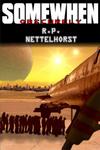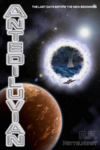Interesting article on io9.com, a website devoted to science fiction:
Christian readers demand more science fiction books. Why won't Christian publishers listen?
As a Christian who reads and writes science fiction, it is a bit of a puzzle. On the other hand, my very secular, small press editor for my novels Antediluvian, Somewhen Obscurely, and Inheritance had no problem with the Christian and religious elements in my stories. So even if Christian publishers won't handle science fiction, there are plenty of mainstream publishers who don't mind Christian or religious themed science fiction. For instance, religion plays a role in many of Robert J. Sawyer's novels. His publisher is Tor, one of the biggest names in science fiction publishing. His novel, Calculating God, is a fascinating book. I don't know his personal beliefs, but his novels nevertheless do not fear to examine seriously a variety of theological and religious topics.
Monday, June 28, 2010
Tuesday, June 22, 2010
Saturday, June 19, 2010
Quote for A Saturday Morning
“There is a theory which states that if ever anybody discovers exactly what the Universe is for and why it is here, it will instantly disappear and be replaced by something even more bizarre and inexplicable. There is another theory which states that this has already happened.” Douglas Adams
Wednesday, June 09, 2010
Synthetic Life
This is a good summary of what Craig Ventner and his team announced regarding the creation of synthetic life. It is taken from Jerry Pournelle's website, Chaos Manor:
On May 19. Craig Venter announced that his team at the Venter Institute in La Jolla had succeeded in creating synthetic life. Why has this attracted so little attention?
Venter became famous a decade ago because he was frustrated with the slow progress and high cost of the NIH Human Genome Project, which began in 1990. In 1997 he founded Celera Corporation, which did the job in 3 years at a cost of $300 million. The government-funded effort took 13 years, finishing in 2003, and cost $2.7 billion.
What Venter et al have now done is as follows:
(1) They sequenced the genome of the bacterium Mycoplasma mycoides (which causes lung disease in goats). Its DNA has 1.08 million base pairs.
(2) Starting with the chemicals adenine (A), guanine (G), cytosine (C) and thymine (T) which make up the genetic code, they synthesized stretches of DNA corresponding to segments of the M. mycoides DNA and then managed to get them all to hook up in the right sequence. Thus they constructed from scratch a copy of the bacterium's DNA.
(3) They inserted this synthetic DNA into a different bacterium, M. capricolum, which had had the genes for its restriction enzymes removed (which means that it had no defenses against foreign DNA). The synthetic DNA took over, and the cells started reproducing and behaving just like natural M. mycoides.
A good way of looking at this is that they have taken the cell machinery ("hardware") of M. capricolum and replaced its software (the DNA), which tells it what kind of creature it should be. Having a cell "boot up" with entirely artificial software is an astounding achievement.
There is now a live bacterium in La Jolla whose genetic code was not determined by evolution but by typing it on a computer. This is the first unequivocal example of Intelligent Design – but the Intelligent Designer was Craig Venter, not God.
In my opinion, there have been five major revolutions in human society: the Agricultural Revolution, the Industrial Revolution, the breakout into space, the computer revolution, and now the creation of artificial life. This is HUGE.
In this first test, the team copied natural DNA, but now they can begin exploring variations, perhaps producing wholly new life forms. A major goal is to understand what features of DNA are essential for viable life. Venter's company, Synthetic Genomics Inc., hopes to start producing designer bacteria that can do things like making fuel from algae or cleaning up oil spills.
It is a long way from synthetic bacteria to synthetic differentiated creatures (e.g., living androids), but the way is now open. It will happen sooner than we expect. We need to start thinking about the ethical implications.
All DNA has long stretches of base pairs ("junk DNA") with no known function. Although some of it surely does things we don't yet understand, it appears that you can add arbitrary segments without affecting viability. There are 256 ways to choose the 4 bases in a stretch of four, so you can use combinations of four base pairs to represent letters, punctuation, etc. Venter & co devised such an alphabet, and included quite a bit of text in their synthetic M. mycoides. The information includes the following quotes: "TO LIVE, TO ERR, TO FALL, TO TRIUMPH, TO RECREATE LIFE OUT OF LIFE." - JAMES JOYCE; "SEE THINGS NOT AS THEY ARE, BUT AS THEY MIGHT BE.”- J. ROBERT OPPENHEIMER; "WHAT I CANNOT BUILD, I CANNOT UNDERSTAND." - RICHARD FEYNMAN.
We need an international agreement about the code used to include text in synthetic DNA, and a requirement that it include info about its origin (so that any life that escapes control can be identified).
Incidentally, the human genome has 3.3 billion base pairs, and 96% of it is thought to be junk. This suggests that you could encode the St James Bible four times over in a strand of human DNA, and still have it work to create a human being.
Science fiction story: we find that human junk DNA is not random; we crack the code, and find a long message encoded in our genome. It could be instructions for interstellar communication, left by aliens who created us, or it might be a version of the Bible, in Aramaic…
Phil Chapman
Tuesday, June 08, 2010
Friday, June 04, 2010
SpaceX Falcon 9 Reaches Orbit on its Inaugural Flight
You can watch a highlight of the launch of the first Falcon 9 rocket on the SpaceX website:
Video Highlights of Launch
Details about the Falcon 9:
Like Falcon 1, Falcon 9 is a two stage, liquid oxygen and rocket grade kerosene (RP-1) powered launch vehicle. It uses the same engines, structural architecture (with a wider diameter), avionics and launch system.
Length: 54.9 m (180 ft)
Width: 3.6 m (12 ft)
Mass (LEO, 5.2m fairing): 333,400 kg (735,000 lb)
Mass (GTO, 5.2m fairing): 332,800 kg (733,800 lb)
Thrust (vacuum): 4.94 MN (1,110,000 lbf)
Nine SpaceX Merlin engines power the Falcon 9 first stage with 125,000 lbs-f sea level thrust per engine for a total thrust on liftoff of just over 1.1 Million lbs-f. After engine start, Falcon is held down until all vehicle systems are verified to be functioning normally before release for liftoff.
In December 2008, NASA announced the selection of SpaceX's Falcon 9 launch vehicle and Dragon Spacecraft to resupply the International Space Station (ISS) when the Space Shuttle retires in 2010. The $1.6 billion contract represents a minimum of 12 flights, with an option to order additional missions for a cumulative total contract value of up to $3.1 billion.
The Dragon Spacecraft, launched by a Falcon 9, besides hauling cargo, was designed to be human crewed. Within three years it could be hauling seven people into orbit.
Video Highlights of Launch
Details about the Falcon 9:
Like Falcon 1, Falcon 9 is a two stage, liquid oxygen and rocket grade kerosene (RP-1) powered launch vehicle. It uses the same engines, structural architecture (with a wider diameter), avionics and launch system.
Length: 54.9 m (180 ft)
Width: 3.6 m (12 ft)
Mass (LEO, 5.2m fairing): 333,400 kg (735,000 lb)
Mass (GTO, 5.2m fairing): 332,800 kg (733,800 lb)
Thrust (vacuum): 4.94 MN (1,110,000 lbf)
Nine SpaceX Merlin engines power the Falcon 9 first stage with 125,000 lbs-f sea level thrust per engine for a total thrust on liftoff of just over 1.1 Million lbs-f. After engine start, Falcon is held down until all vehicle systems are verified to be functioning normally before release for liftoff.
In December 2008, NASA announced the selection of SpaceX's Falcon 9 launch vehicle and Dragon Spacecraft to resupply the International Space Station (ISS) when the Space Shuttle retires in 2010. The $1.6 billion contract represents a minimum of 12 flights, with an option to order additional missions for a cumulative total contract value of up to $3.1 billion.
The Dragon Spacecraft, launched by a Falcon 9, besides hauling cargo, was designed to be human crewed. Within three years it could be hauling seven people into orbit.
Subscribe to:
Comments (Atom)




